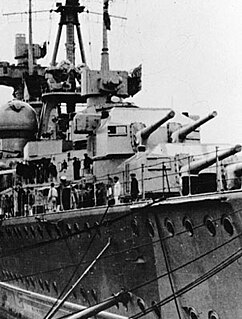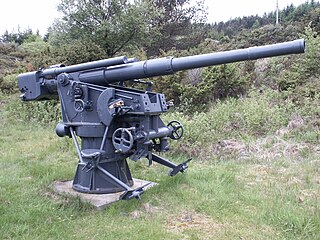
The Type 10 or 12 cm/45 10th Year Type naval gun was a Japanese 120 mm calibre dual purpose anti-aircraft and coastal defense gun used during the Second World War. It was derived from the 12 cm/45 3rd Year Type naval gun. The Type 10 number was designated for the year the gun was accepted,the 10th year of Emperor Taishō's reign, 1927 in the Gregorian calendar. It served as the secondary armament on a number of Japanese aircraft carriers and cruisers and as the primary armament on smaller ships.

The QF 4 inch Mk XVI gun was the standard British Commonwealth naval anti-aircraft and dual-purpose gun of World War II.

The 15 cm SK L/45 was a German naval gun used in World War I and World War II.

The 45 mm anti-aircraft gun (21-K) was a Soviet design adapted from the 45 mm anti-tank gun M1932 (19-K). This was a copy of a 3.7 cm (1.5 in) German weapon designed by Rheinmetall that was sold to the Soviets before Hitler came to power in 1933 that had been enlarged to 45 mm (1.8 in) to reuse a large stock of old 47mm ammunition. It was used by the Soviet Navy to equip almost all of their ships from 1934 as its primary light anti-aircraft gun until replaced by the fully automatic 37 mm 70-K gun from 1942 to 1943. It was used in World War II and during the Cold War as the Soviets exported their World War II-era ships to their friends and allies. However it was not very effective as its slow rate of fire and lack of a time fuze required a direct hit to damage targets.

The 50 calibre BL 8 inch gun Mark VIII was the main battery gun used on the Royal Navy's County-class heavy cruisers, in compliance with the Washington Naval Treaty of 1922. This treaty allowed ships of not more than 10,000 tons standard displacement and with guns no larger than 8 inches (203 mm) to be excluded from total tonnage limitations on a nation's capital ships. The 10,000 ton limit was a major factor in design decisions such as turrets and gun mountings. A similar gun formed the main battery of Spanish Canarias-class cruisers. In 1930, the Royal Navy adopted the BL 6 inch Mk XXIII naval gun as the standard cruiser main battery in preference to this 8-inch gun.

Third year type 20 cm/50 caliber guns formed the main battery of Japan's World War II heavy cruisers. These guns were also mounted on two early aircraft carriers. The typical installation was ten 20 cm/50 guns; although Tone-class cruisers carried eight while Furutaka and Aoba-class cruisers carried six. After modernization, Akagi carried only six.

The 20.3 cm SK C/34 was the main battery gun used on the German Admiral Hipper-class heavy cruisers.

The 203 mm/53 Ansaldo was the main battery gun of Italy's most modern Washington Naval Treaty heavy cruisers. This treaty allowed ships of not more than 10,000 tons standard displacement, and with guns no larger than 8 inches (203 mm), to be excluded from total tonnage limitations on a nation's capital ships.

The 8.8 cm SK C/30 was a German naval gun that was used in World War II. The SK C/30 guns were intended for smaller warships such as submarine chasers and corvettes.

The 10 cm/65 Type 98 naval gun (六五口径九八式一〇糎高角砲), also known as the long 10cm high-angle gun (長10センチ高角砲), was a light caliber naval gun of the Imperial Japanese Navy used during World War II. It was employed on the aircraft carrier Taihō, the light cruiser Ōyodo, and Akizuki-class destroyers. From 1945, land-based installations became more prioritized. The gun was considered by the Japanese to be their finest anti-aircraft artillery weapon. After the end of World War II, the gun remained in service on the two Japanese destroyers ceded to the Soviet Union and the Republic of China as war reparations.
The Cannone da 135/45 OTO 1937 was a 135 mm (5.3 in) 45-caliber naval gun built for the Regia Marina in the late 1930s. Built as a response to the French Canon de 138 mm Modèle 1929, it was meant to have the same range as the widespread 120 mm gun, but with less muzzle velocity and less dispersion.
The Canon de 194 mm Modèle 1902 was a medium-caliber naval gun used as the primary or secondary armament in both casemates and turrets of a number of French pre-dreadnoughts and armored cruisers during World War I. After World War I these ships were scrapped and some were later reused as coastal artillery in World War II
The Canon de 152 mm Modèle 1930 was a medium-caliber naval gun used as the primary armament on a number of French cruisers and as dual-purpose secondary armament on Richelieu-class battleships during World War II.
The Canon de 130 mm Modèle 1932 and 1935 were medium-caliber naval guns used as the primary armament on a number of French Navy destroyers and as dual-purpose secondary armament on battleships during World War II.
The Canon de 130 mm Modèle 1924 was a medium-caliber naval gun used as the primary armament on a number of French destroyers during World War II.
The Canon de 130 mm Modèle 1919 was a medium-caliber naval guns used as the primary armament on a number of French Destroyers during World War II.
The Canon de 90 mm Modèle 1926 was a light-caliber Dual-purpose gun used as primary armament on minesweeping sloops and anti-aircraft armament on a number of French Navy cruisers and battleships during World War II.
The 203 mm /50 Model 1924 was an Italian 203 mm naval gun. Manufactured by the Ansaldo engineering company in the years before World War II for the Italian Navy, the use of these guns was limited to the Trento-class heavy cruisers and coastal defense batteries during the second world war.
The 152 mm /53 Model 1926–1929 were built for the Italian Navy in the years before World War II. These guns were used on all Condottieri-class light cruisers except the Duca degli Abruzzi-class.
The 152 mm /55 Model 1934–1936 were built for the Italian Navy in the years before World War II. These guns were used on the Duca degli Abruzzi-class Light cruisers, which were the final series of the Condottieri-class cruisers as their primary armament and as secondary armament on the Littorio-class battleships.


















